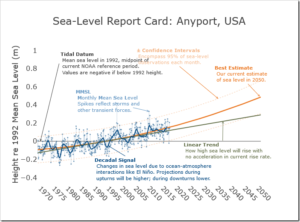by P. Homewood, February 19, 2020 in NotaLotofPeopleKnowThat
This has to go down as one of the most fraudulent climate studies yet!
Want to know how sea level in your area is changing due to global warming and other factors? Our ‘report cards’ can help. Updated by the Virginia Institute of Marine Science each year as annual tide-gauge data become available, they display recent sea-level trends and project sea-level height to the year 2050 for 32 localities along the U.S. East, Gulf, West, and Alaskan coasts.
Report Card Components
Our report cards have 3 components: the 2050 projection, recent trends in the rates of sea-level change, and an explanation of processes affecting sea level at each locality.
The annotated chart below, using the latest data from Norfolk, Virginia, briefly explains the data and statistical approaches we use in our 2050 projections. Visit an individual locality for details on all its report-card components. You can also compare sea-level trends, projections and processes among localities and by region. For full technical details, read our report.

https://www.vims.edu/research/products/slrc/index.php
…
…
by Donna Laframboise, February 19, 2020 in BigPictureNews
The UN couldn’t help Haiti recover from an earthquake. But it imagines we’d all perish without it.
UNESCO is supposed to be about cultural preservation. Toward the end of last year, its in-house magazine nevertheless published a special issue on climate change. The official editorial employs the usual cliches. Catastrophic consequences. The “greatest global challenge of our times.” Blah, blah.
Hilariously, this editorial implies that, without a UN plan, the planet simply won’t survive. Earth to UNESCO: could we spend five minutes talking about how the UN has failed – tragically and comprehensively – to save Haiti?
That nation has less than 12 million people. It’s slightly smaller than the US state of Maryland. Because it comprises half of an island, its borders are well-defined. The UN has had a significant presence there since 2004, yet Haiti remains a basket case.
After a devastating earthquake struck in 2010, rebuilding was a huge job at which the UN was spectacularly inept. But that isn’t the half of it. UN peacekeepers then infected the already traumatized local population with cholera.
The peacekeepers were from Nepal, which had just experienced a cholera outbreak. The UN took no steps to ensure its personnel weren’t carrying the disease. Nor did it establish proper sanitation at their encampment. Untreated sewage got dumped into the country’s most important river, contaminating water that was used for drinking, cooking, and bathing.
…
La géologie, une science plus que passionnante … et diverse

